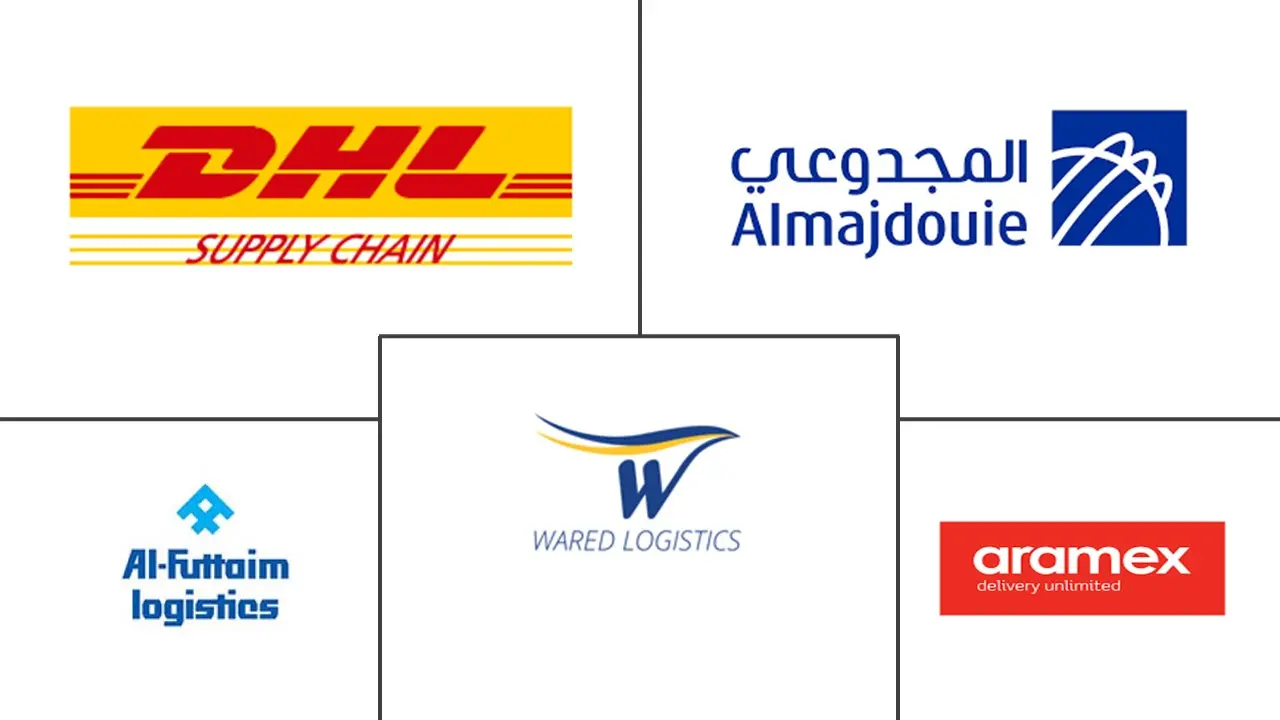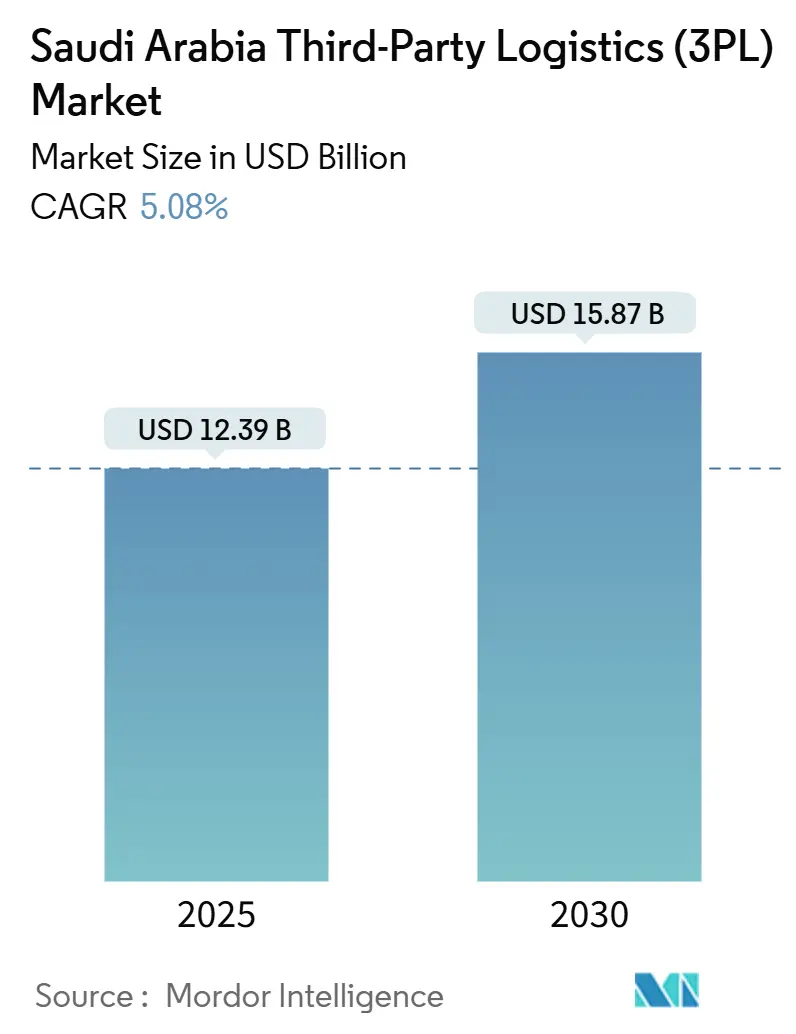
Saudi Arabia Third-Party Logistics (3PL) Market Analysis by Mordor Intelligence
The Saudi Arabia Third-Party Logistics Market size is estimated at USD 12.39 billion in 2025, and is expected to reach USD 15.87 billion by 2030, at a CAGR of 5.08% during the forecast period (2025-2030).
Growth is fueled by the National Transport & Logistics Strategy’s USD 266 billion investment pipeline, the rollout of multiple special economic zones, and full liberalization of foreign ownership that collectively attract global providers[1]Khalid Al-Falih, “National Transport & Logistics Strategy—Investment Fact Sheet 2025,” Ministry of Transport and Logistic Services, mot.gov.sa. Digitalization initiatives such as the Logisti 2 platform and the Ports Community System simplify more than 390 logistics processes, accelerating shipment visibility, customs clearance, and multimodal coordination. Cross-border trade volumes climb on the back of new GCC and Asia–Europe corridors, while pharmaceutical cold-chain build-outs and e-commerce reverse-logistics services open niche revenue streams. Competition intensifies as international players commit over USD 500 million of fresh capital through 2030, prompting local firms to deploy asset-light models and automation to preserve margins.
Key Report Takeaways
- By Service, Domestic Transportation Management captured 43% of Saudi Arabia 3PL market share in 2024. While, International Transportation Management is forecast to expand at a 5.80% CAGR through 2030 within the Saudi Arabia 3PL market.
- By End User, Energy & Utilities led with 22% of the Saudi Arabia 3PL market size in 2024. Whereas, Life Sciences & Healthcare is advancing at a 7.10% CAGR between 2025-2030 within the Saudi Arabia 3PL market.
- By Logistics Model, Asset-Heavy models held 39% of the Saudi Arabia 3PL market share in 2024. Meanwhile, Asset-Light approaches are projected to grow at a 6.10% CAGR through 2030 in the Saudi Arabia 3PL market.
Saudi Arabia Third-Party Logistics (3PL) Market Trends and Insights
Drivers Impact Analysis
| Driver | (~) % Impact on CAGR Forecast | Geographic Relevance | Impact Timeline |
|---|---|---|---|
| Expansion of cross-border trade volumes | +1.2% | GCC links, Asia–Europe corridors | Long term (≥ 4 years) |
| Infrastructure modernization under National Transport & Logistics Strategy | +0.9% | Riyadh, Jeddah, Dammam, NEOM | Medium term (2-4 years) |
| Logistics zones & SEZ roll-out (Vision 2030) | +0.7% | Riyadh, Jeddah, Eastern Province | Medium term (2-4 years) |
| Surge in e-commerce return flows (reverse logistics) | +0.5% | Urban centers | Short term (≤ 2 years) |
| Temperature-controlled pharma distribution boom | +0.4% | Major cities | Medium term (2-4 years) |
| 100% foreign-ownership rule attracting MNC 3PLs | +0.6% | Ports and airports | Short term (≤ 2 years) |
| Source: Mordor Intelligence | |||
Expansion of Cross-Border Trade Volumes
Saudi non-oil exports reached USD 137 billion in 2024, a 13% year-on-year jump that underscores rising demand for integrated freight solutions. Global liners such as CMA CGM are investing in Red Sea intermodal hubs, demonstrating confidence in the long-term alignment between corridor diversification and the Saudi Arabia 3PL market. New land bridges and rail links strengthen Saudi positioning as a midpoint between Asia and Europe, pushing international 3PLs to scale regional capacity. Customs reforms coupled with GCC harmonization streamline transit time, prompting shippers to consolidate flows through the Kingdom. Providers that combine network reach with localized compliance support gain a durable competitive edge.
Infrastructure Modernization Under National Transport & Logistics Strategy
The USD 266 billion public-sector capex plan unlocks green-field ports, railroads, dry ports, and bonded zones, sharply reducing gateway congestion. Synchronized digital platforms, including Logisti 2 and the Ports Community System, cut documentation cycles by double-digit percentages, raising asset utilization and boosting the Saudi Arabia 3PL market. NEOM’s automated cranes, slated to be operational by 2026, set new benchmarks for handling efficiency. With 76% growth in logistics business registrations in Q2 2024, private capital flows swiftly follow public spending, expanding warehouses and cross-docks nationwide. Robust infrastructure shrinks domestic haul time, supporting multimodal growth while elevating service standards[1]Tariq Al-Shami, “Quarterly Logistics Business Registration Statistics—Q2 2024,” General Authority for Small and Medium Enterprises (Monsha’at), monshaat.gov.sa.
Logistics Zones & SEZ Roll-out (Vision 2030)
Tax-free logistics enclaves such as the Special Integrated Logistics Zone grant 0% corporate income tax for 50 years alongside customs deferral privileges . Developers like GFH Financial Group plan 200,000 m² of Grade-A facilities across Riyadh, Jeddah, and Dammam, providing turnkey space for high-value inventory. Multinationals embed distribution centers within these zones to serve the broader MEA region, fueling throughput across the Saudi Arabia 3PL market. SEZ authorities incorporate renewable energy and smart-building norms, trimming lifecycle costs while meeting ESG mandates. The resulting cluster effect deepens service specialization, accelerates technology diffusion, and tightens labor markets for niche skills.
Surge in E-commerce Return Flows (Reverse Logistics)
Return ratios near 30% in apparel and consumer electronics segments force shippers to prioritize agile reverse-logistics networks. Same-day preferences in Riyadh and Jeddah intensify last-mile complexity, prompting 3PLs to pilot autonomous vans and micro-fulfillment hubs. Government-backed e-commerce councils push cash-to-card migration, altering COD reconciliation workflows and heightening the need for real-time inventory control. Smart lockers and data-driven routing lower customer wait times, driving adoption of dedicated returns management offerings in the Saudi Arabia 3PL market. Firms that pair dynamic fleet sizing with predictive analytics capture expanding aftermarket revenue.
Restraint Impact Analysis
| Restraint | (~) % Impact on CAGR Forecast | Geographic Relevance | Impact Timeline |
|---|---|---|---|
| High operating & compliance costs (incl. Saudization) | -0.8% | Nationwide, labor-intensive sites | Medium term (2-4 years) |
| Skilled-labor shortage | -0.6% | Technical and managerial roles | Long term (≥ 4 years) |
| Fragmented digital standards across ports & customs | -0.4% | Gateway nodes | Short term (≤ 2 years) |
| Seasonal trucking capacity squeeze (Hajj/Umrah) | -0.3% | Makkah–Medina corridor | Short term (≤ 2 years) |
| Source: Mordor Intelligence | |||
High Operating & Compliance Costs (Including Saudization)
Enhanced Nitaqat thresholds mandate 70% Saudi labor in healthcare logistics and 40% in consulting activities, inflating payroll outlays and recruitment lead times. Non-compliance limits visa quotas and access to public contracts, adding operational risk to the Saudi Arabia 3PL market. By 2024, 2.34 million nationals were employed in the private sector, but the pipeline of job entrants is projected to hit 5 million by 2030. Reskilling spend rises as firms build academies to meet localization audits. While grants and wage subsidies ease transition pain, tight margins remain a structural headwind[3]Ahmed Al-Humaid, “Updated Saudization Ratios for Logistics and Healthcare 2024,” Ministry of Human Resources and Social Development, hr.gov.sa.
Skilled-Labor Shortage
Facility automation, AI-driven routing, and cold-chain stewardship demand hybrid digital-operations skills that remain scarce domestically. Mega-projects such as NEOM compete aggressively for technicians, creating wage spirals in the Saudi Arabia 3PL market. Industry-academia partnerships attempt to speed credentialing, yet long lead times limit short-term relief. Without well-trained operators, technology ROI lags, and service quality variations widen. Retention schemes and career pathways grow in importance as labor mobility rises.
Segment Analysis
By Service: Digital Integration Drives International Growth
International Transportation Management generated a 5.80% CAGR outlook, signaling accelerating cross-border activity and technology-enabled corridor orchestration in the Saudi Arabia 3PL market. Customs cycle reduction through the Ports Community System strengthens comparative transit time, while CMA CGM’s Red Sea investments widen modal options for exporters. International contract wins offset the 43% domestic share led by in-country transport management, indicating a gradual rebalancing toward global flows. The Saudi Arabia 3PL market size for International Transportation Management is forecast to climb alongside non-oil export gains.
Value-Added Warehousing & Distribution benefits from automation adoption across pharmaceutical and e-commerce facilities. Providers integrate WMS, AS/RS, and cold rooms to meet stringent handling standards. Road haulage remains volume leader due to a 221,000 km highway network, while air cargo enjoys gateway expansions at Riyadh and Dammam. Rail and sea corridors attract fresh capital as dry ports and intermodal yards come online. Digital platforms stitch these modes together, positioning end-to-end visibility as a baseline expectation.
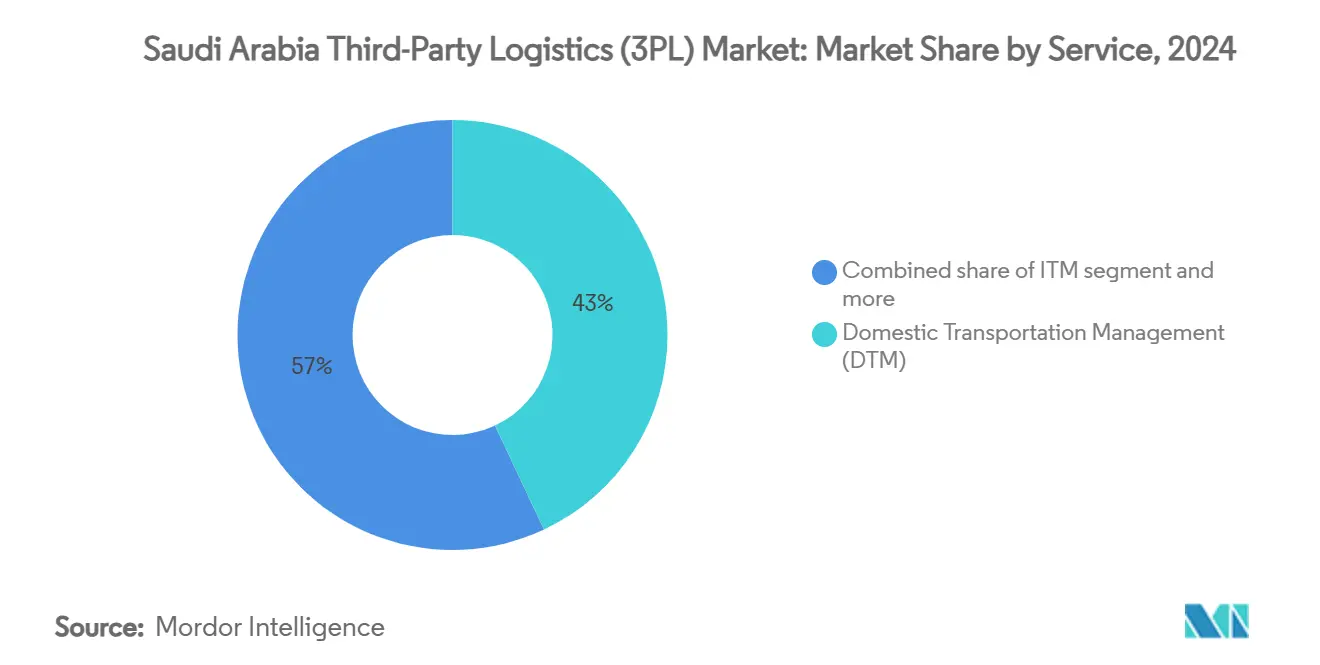
Note: Segment shares of all individual segments available upon report purchase
By End User: Healthcare Acceleration Challenges Energy Dominance
Energy & Utilities retained 22% of Saudi Arabia 3PL market share in 2024 due to upstream and giga-project logistics needs. However, Life Sciences & Healthcare is on track for a 7.10% CAGR, eroding the historical gap through 2030 as vaccine throughput and biologics imports multiply. The Saudi Arabia 3PL market size for healthcare shipments is boosted by Naqel Express’s specialized cold-chain spend and government stockpiling mandates.
Automotive demand gains momentum after Hyundai broke ground on a 50,000-unit factory scheduled for late 2026 production. Manufacturing, FMCG, and Retail all experience heightened throughput because of population growth and tourism lifts. Digital manufacturing initiatives within Vision 2030 push localized component sourcing, intensifying intra-kingdom freight. As a result, the end-user mix for the Saudi Arabia 3PL market diversifies, gradually diluting oil-centric volatility.
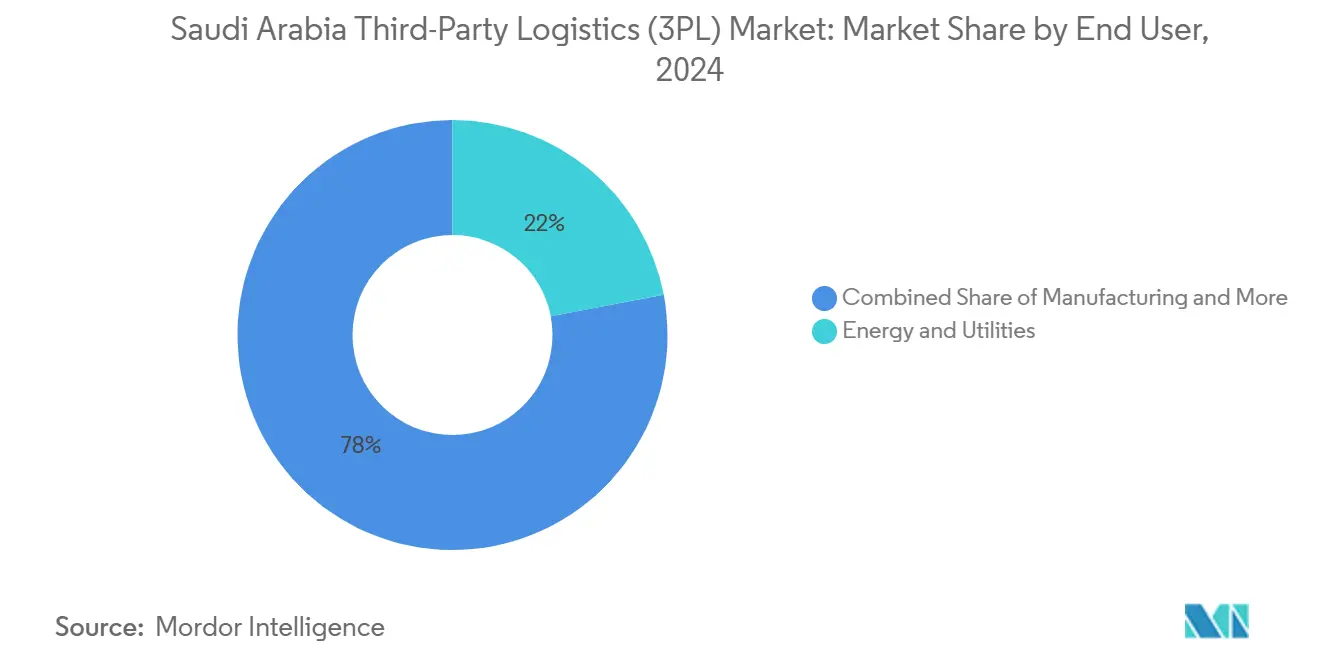
Note: Segment shares of all individual segments available upon report purchase
By Logistics Model: Partnership Strategies Accelerate Asset-Light Growth
Asset-Light contracts are forecast to rise at 6.10% CAGR, reflecting foreign JV appetite and preference for management income over heavy capex. CEVA’s partnership with Almajdouie combines a fleet of 2,000 assets with global process discipline, demonstrating scalability without full ownership. The Saudi Arabia 3PL market size for Asset-Light revenue streams grows as digital control towers orchestrate subcontracted fleets.
Hybrid arrangements mix strategic warehouse ownership with outsourced line-haul, offering resilience against asset utilization swings. DHL’s ASMO venture with Aramco showcases data-analytics overlays that optimize energy-sector supply chains while capping fixed costs. Asset-Heavy models still dominate petrochemical projects requiring bespoke rigs, but rising compliance expenditures tilt newcomers toward lighter balance sheets. Multimodal orchestration platforms knit asset-light partners into reliable capacity pools, supporting service-level guarantees.
Geography Analysis
The Red Sea corridor anchors west-coast volumes, leveraging adjacency to Suez-bound traffic and emerging African trade. Jeddah Islamic Port upgrades and CMA CGM’s concession commitments reinforce gateway competitiveness, channeling incremental TEUs into the Saudi Arabia 3PL market. Inland distribution from Jeddah feeds NEOM, where automated cranes will manage mega-vessel calls once Terminal 1 opens in 2026.
The Eastern Province hinges on Dammam’s King Abdulaziz Port and its petrochemical hinterland, concentrating bulk and project cargo. Integrated rail and road grids ferry freight westward, while the GCC rail link promises seamless cross-border runs. Riyadh remains the administrative heart, with Riyadh Integrated Logistics Zone and multiple dry ports consolidating the nation’s distribution command functions. Government records show logistics business registrations climbed 76% year-on-year in Q2 2024, highlighting the capital’s magnetism for new entrants.
Pilgrim transit shapes the Hejaz sub-region, imposing unique seasonality that necessitates purpose-built staging yards and temperature-controlled rest areas. Secondary airports such as Taif witness upgrades through SAL Saudi Logistics Services’ partnerships that extend cargo reach into interior cities. Across all regions, the Logisti 2 platform standardizes permit issuance and visibility, knitting disparate nodes into a cohesive digital spine. Foreign operators increasingly view the Saudi Arabia 3PL market as a multi-regional network rather than isolated gateways, supporting long-term scale economies.
Competitive Landscape
Top Companies in Saudi Arabia Third-Party Logistics Market
The Saudi Arabia 3PL market hosts a balanced mix of global brands and domestic champions, with consolidation underway as ownership rules ease. CEVA–Almajdouie and DHL–Aramco alliances exemplify hybrid structures that marry international best practice with local market bonds. DHL Group alone pledged over USD 574.5 million for regional expansion to 2030, a sizable war chest that signals elevated rivalry. CMA CGM’s infrastructure play on the Red Sea injects container-line capital into inland transfer hubs, intensifying port-centric competition.
Technology shapes differentiation: AI-enabled warehouse orchestration cuts pick errors, while drone pilots test stock-yard surveillance for safety compliance. Leaders integrate IoT sensors into reefer fleets, offering GDP-validated traceability that underpins healthcare gains in the Saudi Arabia 3PL market. Venture capital inflows reached USD 860 million in 2025, nurturing last-mile innovators and freight-matching platforms that add agility. Mid-tier local firms respond with focused vertical niches such as industrial project logistics, leveraging cultural familiarity to defend accounts.
Regulatory incentives within SEZs grant early movers a 50-year tax holiday, encouraging multinationals to lock in sites before capacity fills. Private equity plays favor bolt-on deals to assemble nationwide scale quickly. The competitive field therefore edges toward moderate concentration, with the top five players estimated to control roughly 45% of total revenue in 2025, leaving ample headroom for specialized entrants in the Saudi Arabia 3PL market.
Saudi Arabia Third-Party Logistics (3PL) Industry Leaders
-
Almajdouie Group
-
Al-Futtaim Logistics
-
Wared Logistics
-
DHL Supply Chain
-
Aramex
- *Disclaimer: Major Players sorted in no particular order
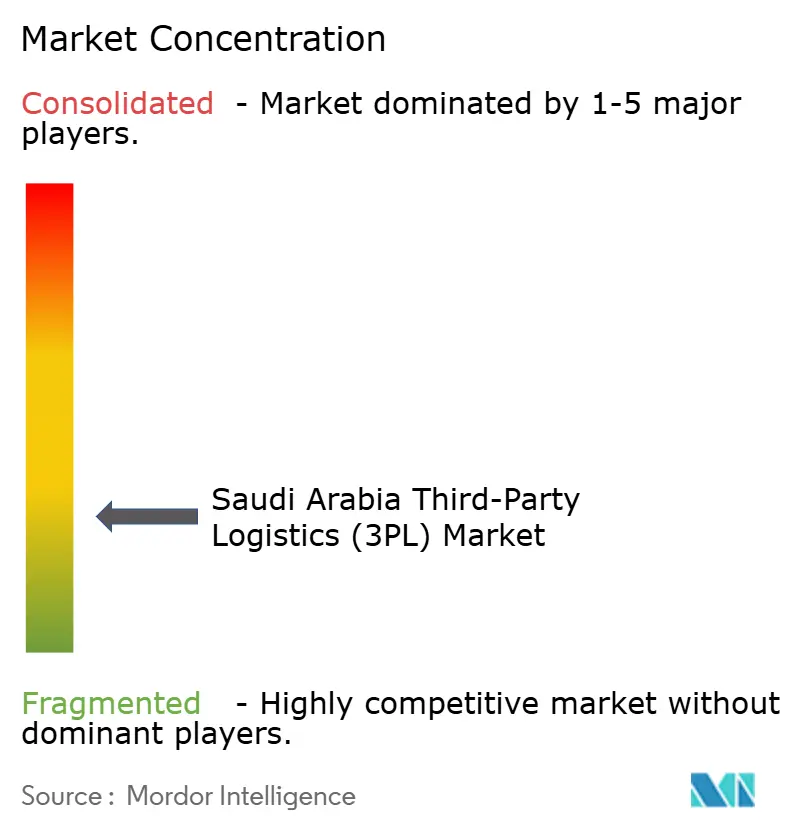


Recent Industry Developments
- June 2025: NEOM installed Saudi Arabia’s first automated remote-controlled cranes ahead of Terminal 1’s 2026 launch, positioning the port for mega-vessel calls.
- June 2025: DHL Group earmarked over USD 574.5 million for Middle East infrastructure, prioritizing Saudi express, forwarding, and e-commerce capacity.
- May 2025: Hyundai and the Public Investment Fund broke ground on a 50,000-vehicle plant in King Abdullah Economic City, bolstering automotive supply-chain demand.
- December 2024: CMA CGM signed a Red Sea logistics enhancement agreement covering terminal upgrades and multimodal platforms.
Saudi Arabia Third-Party Logistics (3PL) Market Report Scope
Third-party logistics, or 3PL, is a system in which one company offers another company inventory management and delivery services. A company that does not have its own logistics department frequently uses a 3PL company.
A complete background analysis of the African cold chain logistics market, including the assessment of the economy and contribution of sectors in the economy, market overview, market size estimation for key segments, and emerging trends in the market segments, market dynamics, and geographical trends, and COVID-19 impact, is covered in the report.
The Saudi Arabian third-party logistics market is segmented by service (domestic transportation management, international transportation management, and value-added warehousing and distribution) and end user (automotive and manufacturing, oil and gas, chemical, distributive trade [wholesale and retail trade, including e-commerce], pharmaceutical and healthcare, construction, and other end users). The report offers market size and forecasts for all the above segments in value (USD).
| Domestic Transportation Management (DTM) | Roadways |
| Railways | |
| Airways | |
| Waterways | |
| International Transportation Management (ITM) | Roadways |
| Railways | |
| Airways | |
| Waterways | |
| Value-Added Warehousing & Distribution (VAWD) |
| Automotive |
| Energy & Utilities |
| Manufacturing |
| Life Sciences & Healthcare |
| Technology & Electronics |
| E-commerce |
| Consumer Goods & FMCG |
| Food & Beverages |
| Others |
| Asset-Light (Management-Based) |
| Asset-Heavy (Own Fleet & Warehouses) |
| Hybrid |
| By Service | Domestic Transportation Management (DTM) | Roadways |
| Railways | ||
| Airways | ||
| Waterways | ||
| International Transportation Management (ITM) | Roadways | |
| Railways | ||
| Airways | ||
| Waterways | ||
| Value-Added Warehousing & Distribution (VAWD) | ||
| By End User | Automotive | |
| Energy & Utilities | ||
| Manufacturing | ||
| Life Sciences & Healthcare | ||
| Technology & Electronics | ||
| E-commerce | ||
| Consumer Goods & FMCG | ||
| Food & Beverages | ||
| Others | ||
| By Logistics Model | Asset-Light (Management-Based) | |
| Asset-Heavy (Own Fleet & Warehouses) | ||
| Hybrid | ||


Key Questions Answered in the Report
How large will logistics outsourcing be in Saudi Arabia by 2030?
The Saudi Arabia 3PL market is expected to reach USD 15.87 billion by 2030, supported by a 5.08% CAGR.
Which service type is expanding fastest in the Kingdom?
International Transportation Management shows the highest growth, projected at a 5.80% CAGR through 2030 as trade corridors widen.
What sector offers the strongest upside for 3PL providers?
Life Sciences & Healthcare is forecast to grow at 7.10% CAGR, driven by cold-chain and pharma investments.
How are foreign ownership changes influencing competition?
The 100% ownership rule has accelerated joint ventures and direct market entry by multinationals, intensifying technology adoption and price competition.The 100% ownership rule has accelerated joint ventures and direct market entry by multinationals, intensifying technology adoption and price competition.
What is the main regulatory hurdle for logistics firms?
Saudization mandates raise labor costs and necessitate substantial training programs to meet localization quotas of up to 70% in certain sub-sectors.
Which regions inside the Kingdom are logistics hot spots?
Jeddah and NEOM anchor the Red Sea corridor, Dammam serves the Gulf coast, and Riyadh functions as the strategic inland distribution hub.
Page last updated on:
